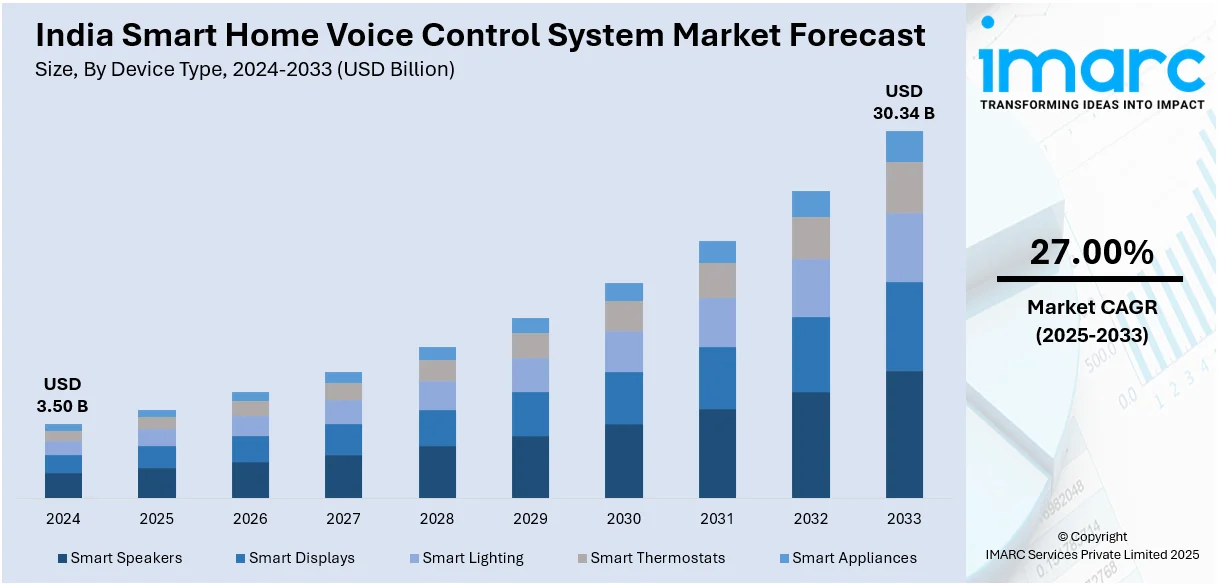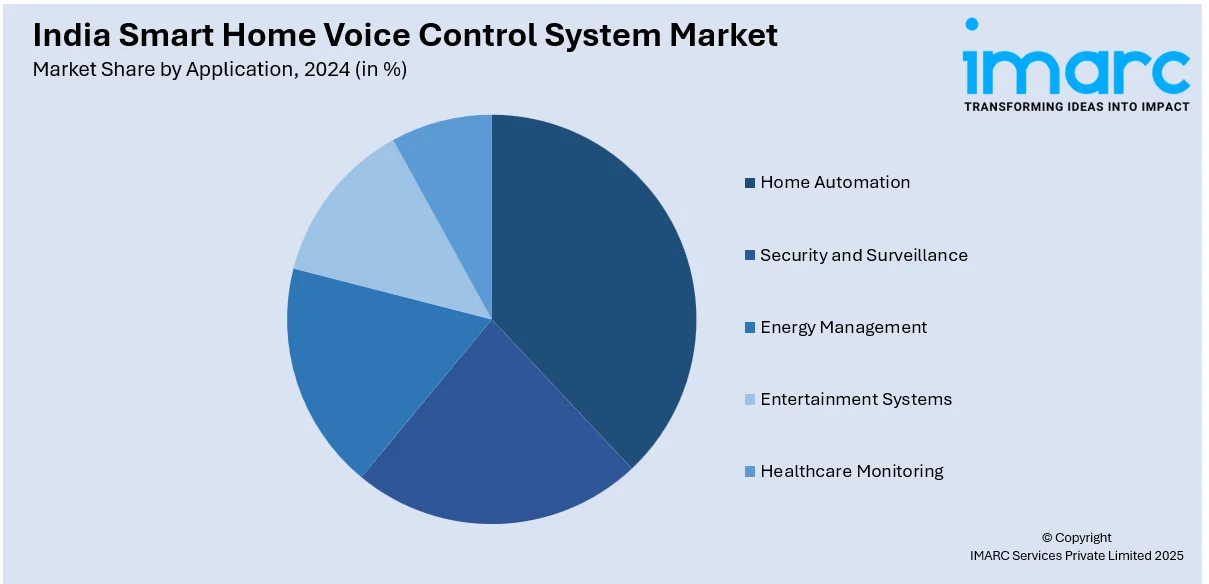
India Smart Home Voice Control System Market Size, Share, Trends and Forecast by Device Type, Technology, Connectivity Type, Application, End User, and Region, 2025-2033
India Smart Home Voice Control System Market Overview:
The India smart home voice control system market size reached USD 3.50 Billion in 2024. Looking forward, IMARC Group expects the market to reach USD 30.34 Billion by 2033, exhibiting a growth rate (CAGR) of 27.00% during 2025-2033. The market is driven by rising smartphone penetration, increasing internet connectivity, and growing adoption of smart home devices. Integration with regional languages, artificial intelligence (AI) advancements, and government initiatives promoting digitalization further fuel demand. Enhanced interoperability, affordability, and consumer preference for convenience also contribute to market growth.
|
Report Attribute
|
Key Statistics
|
|---|---|
|
Base Year
|
2024 |
|
Forecast Years
|
2025-2033
|
|
Historical Years
|
2019-2024
|
| Market Size in 2024 | USD 3.50 Billion |
| Market Forecast in 2033 | USD 30.34 Billion |
| Market Growth Rate 2025-2033 | 27.00% |
India Smart Home Voice Control System Market Trends:
Integration with AI and Machine Learning
Voice control home automation systems are becoming more prevalent in smart homes with the addition of AI and machine learning (ML). AI-powered assistants, including Alexa and Google Assistant, are now more accurate in processing voice commands, forecasting user preference, and automatically handling domestic chores with ease. ML allows such systems to improve over time through learning from usage patterns, leading to enhanced contextual knowledge and customization. This trend is propelling predictive automation, where machines predict user needs in advance based on usage patterns. With multi-command processing and enhanced contextual perception, advanced natural language processing (NLP) is also enhancing the naturalness of voice usage. As AI develops further, voice control solutions for smart homes should become more responsive, efficient, and integrated into everyday life.

To get more information on this market, Request Sample
Enhanced Security and Privacy Features
Advanced encryption and user authentication methods are being used to solve security and privacy concerns as voice-activated smart home devices become more and more common. However, 49% of users remain unaware that voice assistants continuously listen for wake words, and 68% have never taken measures to enhance privacy. To reduce risks, manufacturers are introducing local processing capabilities, lowering the use of cloud and limiting data breaches. Voice recognition and biometric authentication guarantee authorized access to sensitive controls. Privacy settings make users able to control data storage and microphone on/off. With increasing privacy consciousness, companies are focusing on secure voice control solutions, creating a more open and privacy-oriented smart home environment.
Expansion of Interoperability and Device Compatibility
The emergence of open-source platforms and industry-wide standards like Matter is encouraging more interoperability between smart home devices. Historically, voice assistants were in closed ecosystems, so cross-brand compatibility was restricted. But increasing consumer demand for tighter communication between devices has encouraged broader support across several platforms. Users are now able to control all sorts of smart home devices, ranging from lighting to security cameras, regardless of who made them. A more cohesive and approachable smart home environment is being produced by this shift. Smart home systems will become more adaptable and adjustable as more businesses adopt universal communication standards. This is because consumers will be able to connect new gadgets without worrying about brand restrictions or technological incompatibilities.
India Smart Home Voice Control System Market Segmentation:
IMARC Group provides an analysis of the key trends in each segment of the market, along with forecasts at the region level for 2025-2033. Our report has categorized the market based on device type, technology, connectivity type, application, and end user.
Device Type Insights:
- Smart Speakers
- Smart Displays
- Smart Lighting
- Smart Thermostats
- Smart Appliances
The report has provided a detailed breakup and analysis of the market based on the device type. This includes smart speakers, smart displays, smart lighting, smart thermostats, and smart appliances.
Technology Insights:
- Natural Language Processing (NLP)
- Machine Learning Algorithms
- Speech Recognition
- Voice Biometrics
A detailed breakup and analysis of the market based on the technology have also been provided in the report. This includes natural language processing (NLP), machine learning algorithms, speech recognition, and voice biometrics.
Connectivity Type Insights:
- Wi-Fi
- Bluetooth
- Zigbee
- Z-Wave
- Thread
The report has provided a detailed breakup and analysis of the market based on the connectivity type. This includes Wi-Fi, Bluetooth, ZigBee, z-wave, and thread.
Application Insights:

- Home Automation
- Security and Surveillance
- Energy Management
- Entertainment Systems
- Healthcare Monitoring
A detailed breakup and analysis of the market based on the application have also been provided in the report. This includes home automation, security and surveillance, energy management, entertainment systems, and healthcare monitoring.
End User Insights:
- Residential
- Small Office/Home Office (SOHO)
- Commercial
- Industrial
The report has provided a detailed breakup and analysis of the market based on the end user. This includes residential, small office/home office (SOHO), commercial, and industrial.
Regional Insights:
- North India
- South India
- East India
- West India
The report has also provided a comprehensive analysis of all the major regional markets, which include North, South, East, and West India.
Competitive Landscape:
The market research report has also provided a comprehensive analysis of the competitive landscape. Competitive analysis such as market structure, key player positioning, top winning strategies, competitive dashboard, and company evaluation quadrant has been covered in the report. Also, detailed profiles of all major companies have been provided.
India Smart Home Voice Control System Market News:
- In September 2024, ABB India launched ABB-free@home®, an advanced wireless home automation system enhancing comfort, security, and energy efficiency. Featuring Matter Bridge Add-on, it enables seamless integration with Samsung SmartThings, Apple HomeKit, Google Home, Amazon Alexa, and top brands like Philips Hue, Miele, and Sonos. Designed for new and retrofit projects, it optimizes energy use, supporting India's sustainability goals while enhancing modern residential living with smart, connected solutions.
- In February 2024, Amazon launched Alexa+, an advanced AI-powered voice assistant, at $19.99 per month. Announced at the Amazon Devices event, Alexa+ features enhanced conversational AI, smarter task management, and improved personalization to compete with Google and OpenAI. This marks the first major upgrade in nearly a decade, positioning Alexa+ at the forefront of AI-driven voice assistance.
India smart home voice control system Market Report Coverage:
| Report Features | Details |
|---|---|
| Base Year of the Analysis | 2024 |
| Historical Period | 2019-2024 |
| Forecast Period | 2025-2033 |
| Units | Billion USD |
| Scope of the Report | Exploration of Historical Trends and Market Outlook, Industry Catalysts and Challenges, Segment-Wise Historical and Future Market Assessment:
|
| Device Types Covered | Smart Speakers, Smart Displays, Smart Lighting, Smart Thermostats, Smart Appliances |
| Technologies Covered | Natural Language Processing (NLP), Machine Learning Algorithms, Speech Recognition, Voice Biometrics |
| Connectivity Types Covered | Wi-Fi, Bluetooth, Zigbee, Z-Wave, Thread |
| Applications Covered | Home Automation, Security and Surveillance, Energy Management, Entertainment Systems, Healthcare Monitoring |
| End Users Covered | Residential, Small Office/Home Office (SOHO), Commercial, Industrial |
| Regions Covered | North India, South India, East India, West India |
| Customization Scope | 10% Free Customization |
| Post-Sale Analyst Support | 10-12 Weeks |
| Delivery Format | PDF and Excel through Email (We can also provide the editable version of the report in PPT/Word format on special request) |
Key Questions Answered in This Report:
- How has the India smart home voice control system market performed so far and how will it perform in the coming years?
- What is the breakup of the India smart home voice control system market on the basis of device type?
- What is the breakup of the India smart home voice control system market on the basis of technology?
- What is the breakup of the India smart home voice control system market on the basis of connectivity type?
- What is the breakup of the India smart home voice control system market on the basis of application?
- What is the breakup of the India smart home voice control system market on the basis of end user?
- What is the breakup of the India smart home voice control system market on the basis of region?
- What are the various stages in the value chain of the India smart home voice control system market?
- What are the key driving factors and challenges in the India smart home voice control system market?
- What is the structure of the India smart home voice control system market and who are the key players?
- What is the degree of competition in the India smart home voice control system market?
Key Benefits for Stakeholders:
- IMARC’s industry report offers a comprehensive quantitative analysis of various market segments, historical and current market trends, market forecasts, and dynamics of the India smart home voice control system market from 2019-2033.
- The research report provides the latest information on the market drivers, challenges, and opportunities in the India smart home voice control system market.
- Porter's five forces analysis assist stakeholders in assessing the impact of new entrants, competitive rivalry, supplier power, buyer power, and the threat of substitution. It helps stakeholders to analyze the level of competition within the India smart home voice control system industry and its attractiveness.
- Competitive landscape allows stakeholders to understand their competitive environment and provides an insight into the current positions of key players in the market.
Need more help?
- Speak to our experienced analysts for insights on the current market scenarios.
- Include additional segments and countries to customize the report as per your requirement.
- Gain an unparalleled competitive advantage in your domain by understanding how to utilize the report and positively impacting your operations and revenue.
- For further assistance, please connect with our analysts.
 Request Customization
Request Customization
 Speak to an Analyst
Speak to an Analyst
 Request Brochure
Request Brochure
 Inquire Before Buying
Inquire Before Buying




.webp)




.webp)












